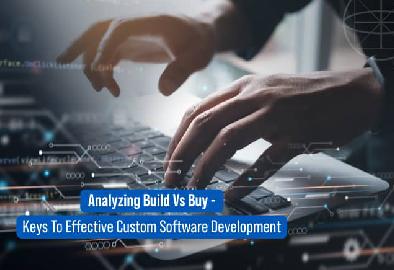Tag: simplify business process
How is RPA turning into a highly sought-after technology
Robotic Process Automation or RPA is one of the fastest-growing segments in the global enterprise software category. Research analyst Gartner says that the market growth rate of RPA was a whopping 63% in 2019. With more enterprises using this innovative technology, RPA’s market value is set to reach 3 billion USD by 2022, shows a prediction by Statista. Early adopters of the RPA software are already raking in benefits as RPA streamlines workflows, automates tasks and allows human workers to focus on high-value work. RPA software appeals to organizations across the world due to its quick deployment cycle time.
How RPA helps businesses: A quick recap
Robotic Process Automation or RPA refers to software programs or ‘bots’ that are programmed to mimic human actions. An average back-office employee has to carry out lots of repetitive, time-consuming and dreary tasks such as producing reports, filling out forms, updating records and other high-volume transactions that do not require judgment or reasoning. RPA simply offers an easy way to perform these tasks more accurately and quickly.
Since RPA does not require any specialized coding knowledge, businesses have welcomed RPA into their processes with open arms. Let’s now have a look at some jaw-dropping statistics and facts about RPA.
Related Reading: How Robotic Process Automation Is Revolutionizing Industries?
Jaw-dropping statistics and facts about RPA
Statistics
The statistics behind the widespread use of this technology can provide us valuable insights into how RPA is impacting the world.
- According to the National Association of Software and Services Companies (NASSCOM), organizations that implement RPA can reduce costs from 35-65% for onshore process operations and 10-30% in offshore delivery.
- McKinsey and Co. suggest that around 45% of the tasks in a business can be automated.
- In their Annual Global RPA survey, Deloitte found that 53% of the survey respondents had already started their RPA journey. Deloitte predicts that we would witness the worldwide adoption of RPA within the next two years.
- Among those surveyed, the ROI was reported at less than 12 months with an average of 20% full-time equivalent capacity provided by robots.
- The Deloitte RPA survey respondents also reported an improvement in compliance (92%), quality/accuracy(90%), productivity(86%) and a reduction in costs(59%).
- The Institute for Robotic Process Automation claims that RPA software robots cost about one-third of the price of an off-shore employee and one-fifth of the price of an onshore worker.
These compelling figures help us to see how RPA is adding value to organizations looking to operate with maximum efficiency.
RPA Facts
- RPA cannot replace humans: One of the biggest misconceptions about RPA is that it will eat up human jobs. RPA works alongside humans to make their lives easier. RPA software carries out jobs that are repetitive and mundane. This can enable us to focus on fruitful endeavors thus improving efficiency.
- RPA will change the nature of outsourcing: RPA has disrupted the outsourcing industry. The increased efficiency and usability that comes with RPA implementation, has threatened traditional BPO relationships. Since RPA can handle more transactions without making mistakes or taking breaks, traditional outsourcing relationships have declined over the last few years. However, if BPOs embrace the benefits of RPA or any other transformative technology they’ll continue to work.
- RPA software implementation is complex: It’s true that RPA has delivered huge benefits to its users. However, many users have also found that the implementation of RPA was quite challenging. Selecting the wrong RPA is one reason that can cause the RPA project to become more complicated than it actually should. If your company doesn’t have an interconnected system that updates cloud or on-premise infrastructure, then RPA implementation can be a big challenge.
- RPA cannot improve a flawed business process: RPA automates processes but does not improve any defects in the existing processes. Due to the hype surrounding RPA, organizations view it as a solution to all their woes. While RPA does help to streamline and modernize processes that are well established, it does nothing to improve a flawed process. So before automating, it’s better to have a clearly defined business process.
- RPA cannot be used to automate all kinds of processes: RPA can be used where high volumes of repetitive transactions based on business rules are carried out. For eg: banking and financial services, insurance, healthcare, pharmaceuticals, manufacturing, travel, logistics, etc. However, if the processes involve reasoning, making decisions, taking different actions according to scenarios, then those processes will not be able to enjoy the full benefits of business automation.
- Future of RPA: RPA has advanced considerably and is the future of IT automation. RPA will be increasingly adopted in various industries such as manufacturing, oil, and gas, retail, etc. Humans will no longer perform data entry and data rekeying jobs. All such jobs would be automated. RPA would evolve to SPA (Smart Process Automation) making business processes smarter. By integrating emerging technologies such as machine learning, AI, big data, with RPA enterprises can promote new levels of productivity and efficiency.
Organizations need not scrap their legacy systems while implementing RPA. The ability of RPA software to integrate legacy systems has helped organizations to accelerate their digital transformation initiatives. They have also unlocked the value associated with past technological investments. As businesses look for new solutions to increase gains, RPA will continue to develop and gain relevance.
Related Reading: How Can Businesses Overcome The Barriers To RPA Adoption?
Have you implemented RPA in your organization? Do you have any insights to share? Do let us know!
Stay up to date on what's new

Featured Blogs
Stay up to date on
what's new



Talk To Our Experts
Stay up to date on what's new

Featured Blogs
Stay up to date on
what's new



Talk To Our Experts
Business leaders, often focusing on the immediate and the more pressing, relegate internal processes to the secondary. As a result, inefficiencies of various hues creep in, over time.
Inefficiencies manifest in many ways. Business processes and systems may be aligned to suit the technology rather than technology being applied to conduct business in the most seamless way. Additional processes may have come up to complete a part of the original process. Often, critical gaps in business processes and data silos make employees struggle to find the right information, or the right tools. The Boston Consulting Group estimates the amount of “procedures, vertical layers, interface structures, coordination bodies, and decision approvals” having increased by anywhere from 50 percent to 350 percent over the last fifteen years, in US and European companies, with managers spending as much as 40% of their time writing reports, and 30% to 60% of their time coordination meetings! The net result is invariably business executives having to work harder than necessary.
One knee-jerk reaction when such inefficiencies become too disruptive to be ignored is automation. However, mere automation of inefficient processes only accentuates waste. While automation is indeed a step in the right direction, businesses need to also make their processes smarter.
Here are a few ways in which business processes can be tweaked to enable working smart instead of working hard.
- Standardize processes, but one size does not always fit all. What works well in one division may not work well for the company overall. 3M found this out the hard way when they applied Six Sigma not just in accounting, but across-the-board, resulting in stifled innovation in a company where innovation is the key USP.
- Innovate. A 2011 PwC study reports 80% of CEOs believing innovation to drive efficiencies and providing a competitive advantage.
- Leverage on-demand and scalable cloud solutions such as PaaS and IaaS to optimize resources, reduce costs, create innovative products and services, and add value to existing business systems.
- Apply technology to tighten collaboration between stakeholders, including customers. Celina Insurance Group implemented a highly collaborative extranet to bring the company employees, 500+ independent agents and customers closer, and offer easy access to all relevant information, resulted in massive gains.
- Integrate the supply chain with business processes, across the value-chain, in real time, to connect people with the information they require. Diary major Danone reduced the timeline of its production optimization plans from two days to a mere 15 minutes now, by updating and integrating its production planning and scheduling technology.
- Leverage analytics to get a 360-degree view, and derive value, from available data. Apply emerging technologies to unlock data and information resident in physical and digital systems, and subject such data to analytics. Ensure such new intelligence is readily available to those in a position to use it, and actionable to make better decisions.
- Enable a mobile workforce capable of collaborating anytime from anywhere. Today’s executives and customers are always on the move. Mobile apps and workflows save time, improve efficiency, and also unlock new possibilities.
About 70% of CEOs invest in IT to reduce costs and to become more efficient, and 54% of them focus on growth initiatives powered by emerging technologies such as mobility. About 80% of manufacturing businesses expect mobile apps to increase their productivity by at least six percent. Mobile phones powered by cloud-based storage and apps allow employees to save a whopping 57 minutes a day, on average.
Smart employees are already up to the task. They often cobble up their own solutions, taking advantage of the tons of resources available online, when existing business resources do not meet their requirements. About 90% of all employees use cloud-based services, such as Skype and LinkedIn, for their work, and 79% of employees use cloud-based file sharing and collaboration tools, such as Dropbox or Microsoft OneDrive. Needless to say, such improvisations do not do away with all inefficiencies and come with grave security and data privacy risks.
Businesses need to facilitate smart employees by developing custom apps that automate workflows, provide digital forms, and sync offline data. A major stumbling block is the extensive time and resources that development of new custom apps requires. IT departments, already hard-pressed to keep existing systems running, often find the task of designing and updating apps that need to work with multiple platforms and disparate devices, too onerous. The solution is to partner with experienced providers, who not only make available complete and customized solutions, but also chips in with their specialized expertise and experience, to realise smart business processes.
Partnering with us allows you to have the best of both worlds – ability to roll out apps that leverage the latest cutting edge technology to enable smart business processes, without straddling your already overburdened and resource-crunched IT team with more responsibilities.
Stay up to date on what's new

Featured Blogs
Stay up to date on
what's new



Talk To Our Experts
In the race towards winning the hearts of customers and gaining maximum profits, business enterprises all over the world are struggling and trying all the latest technology to improve their performance. Business owners are facing many challenges, in terms of production, marketing, transportation and the like, along with the technological improvements.
Apart from these, they also need to deal with issues related to employees, like workload, physical space concerns, customers with specific and unique purchase requirements, logistics issues and the like.
All these adds to the complications that they are facing on a daily basis.
For companies in the field service industry specifically, there may be a lot more issues faced by the owners, as they need to address the concerns of their field staff as well.
You can imagine the level of frustration!
It has been this way for quite some time now. So what have the field service companies resorted to, so as to overcome their challenges and still manage to stay ahead in the competition?
The answer is custom field service software.
Custom Field Service Software To Improve Internal Operations
That’s right. Business owners are now using field service software so as to distribute their operational functions and thereby improve their performances. As is it designed to specifically meet the unique requirements of a business, it could be the perfect way to optimize internal operations.
However, an important thing to note is that, not all solutions are made equal and hence may not do the trick.
So how exactly is field service software helpful in improving internal operations?
The logic is clear
custom software development is developed uniquely for a business. Which means there is a lot of thought and understanding about the different functions and activities of the business going into it.
The solution thus developed, is aligned with the business processes and tasks in such a way that it helps in performing the assigned jobs well within the constraints of the overall goals and policies of the company. It also becomes a treasure trove of comprehensive information about the different products, services and even employees of the company, including how each of these elements interact with each other.
Field service software customized for a business, in the same way, has all of these benefits along with its ability to offer better flexibility and productivity. It makes work easier for everyone and thus improves effectiveness as well.
Now, with field service software, companies are starting to realize that the only way to stand ahead in the competition is to do or have something that their rivals don’t, or have not done yet.
It’s a pretty simple logic, and an evergreen business tactic that is being widely used by field service companies these days. For this reason, companies are now banking on need-driven applications for their organization, and are also hiring highly skilled and reputable developers to create custom field service software that suits their requirements.
Professional software developers can build even the most complex of applications, in a cost effective and scalable manner, to solve business challenges.
With the help of advanced and trending new technologies, guaranteed successful methods and the immense level of broad industry expertise that is worth its value in gold, developers are now equipping business enterprises with just what they need – advanced applications that give them the leading edge, that too, pretty fast and within the budget.
The one concern though, that companies have, about adopting such custom field service software is regarding its initial deployment cost. It may vary according to the different features of each custom application. But due to the advanced capabilities and the level of ubiquity that they provide through web and mobile devices, both of which lead to increased efficiency, the costs can be justified and even brought down.
Hence custom field service software are a worthy investment, that can help simplify processes as well as improve the efficiency of internal operations. All these ultimately lead to improved profits and performance of the entire organization.
Stay up to date on what's new

Featured Blogs
Stay up to date on
what's new






























































